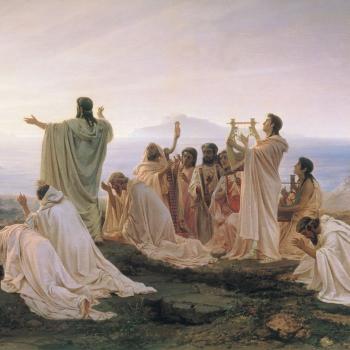
(Wikimedia Commons public domain image)
This was my 2019 Easter column for the Deseret News:
Some dismiss belief in the resurrection of Jesus as reflecting merely “the faded credulity of earlier ages” (for the phrase, see John Updike’s “Seven Stanzas at Easter”; https://www.patheos.com/blogs/danpeterson/2019/04/once-more-john-updikes-seven-stanzas-at-easter.html). The idea, they say, emerges from a pre-scientific era, long before modern medicine, to say nothing of quantum physics and the theory of evolution. As such, modern people can no longer accept it.
Even some purported Christians have reinterpreted the Resurrection as no more than what Updike terms “a parable.” “One cannot use electric light and radio,” declared the German Lutheran theologian Rudolf Bultmann (1884-1976), “and, in the event of illness, avail oneself of modern medical and clinical tools and, at the same time, believe in the spirit- and wonderworld of the New Testament.”
But why not? As a matter of fact, many highly intelligent and well-educated people do use electric lights and radios and modern medicine while believing in the literal resurrection of Jesus.
What is it, exactly, about electronic technology and modern cardiology, for example, that supposedly makes the resurrection any more incredible today than it was in the first century?
Ancient people knew well enough how to distinguish life from death. In some ways, they knew death more intimately than we do, because, unlike today, people didn’t die in sterile hospitals, separated from family and friends by limited visiting hours, hooked up to the wires, tubes and measuring devices of modern technology, surrounded by cool and calm medical professionals. They died at home. And their bodies weren’t whisked away by professional undertakers but were watched over by family members, keeping vigil.
Like ancient Jews generally, the first Christian disciples didn’t believe in Christ’s resurrection because they thought resurrections commonplace. They knew as well as we do that the dead don’t typically get up again.
Many Jews of first-century Palestine believed in a universal resurrection at the end of time, but none expected an individual resurrection in their day:
Thus, when Jesus assured sorrowing Martha that “Thy brother shall rise again,” she replied to him “I know that he shall rise again in the resurrection at the last day.” To which Jesus responded with the stirring declaration: “I am the resurrection, and the life: he that believeth in me, though he were dead, yet shall he live: And whosoever liveth and believeth in me shall never die.” (John 11:23-26)
When Mary Magdalene, Joanna, Mary the mother of James, and the other women that were with them, reported the words of the angels at the tomb to the apostles, Luke tells us, “their words seemed to them as idle tales, and they believed them not.” (Luke 24:9-11)
Despite the repeated teachings of Jesus reported in the four gospels, the first Christians didn’t understand what he was saying.
The two disciples walking the road to Emmaus after the crucifixion weren’t expecting Jesus to reappear at any moment, although they had heard some extremely puzzling reports. They were baffled and discouraged and, when the risen Jesus joined them on their walk, they didn’t even recognize him. (See Luke 24:13-35.)
When Jesus stood amid the disciples in the upper room in Jerusalem, they didn’t respond with a nonchalant “What took you so long?” They were perplexed and frightened. “Behold my hands and my feet,” he said, to calm their fears and answer their questions, “that it is I myself: handle me, and see; for a spirit hath not flesh and bones, as ye see me have.” Even so, Luke records, “they yet believed not for joy, and wondered.” So, to demonstrate his down-to-earth physical reality in a very practical and earthly way, he took a broiled fish and a honeycomb and ate “before them.” (See Luke 24:36-43.)
However, the apostle Thomas was not present when Jesus appeared to them and, according to John, when his fellow apostles told him “We have seen the Lord,” he reacted not with overeager gullibility, but with skepticism: “Except I shall see in his hands the print of the nails,” he said, “and put my finger into the print of the nails, and thrust my hand into his side, I will not believe.” (See John 20:24-29.)
In due course, Thomas too was convinced. Ancient accounts relate that he was martyred in distant India, bearing witness to the resurrection of his Lord.
There is little reason beyond smug prejudice to assume that the story of Christ’s resurrection emerged out of ancient ignorance of modern technology and modern medicine.












